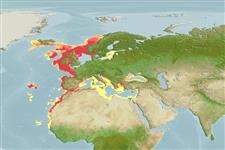Elasmobranchi (squali e razze) (sharks and rays) >
Rajiformes (Skates and rays) >
Rajidae (Skates)
Etymology: Dipturus: Greek, di = two + Greek, pteryx = fin (Ref. 45335).
More on author: Linnaeus.
Environment: milieu / climate zone / depth range / distribution range
Ecologia
marino demersale; distribuzione batimetrica 100 - 1000 m (Ref. 4426), usually 30 - 600 m (Ref. 127222). Temperate; 70°N - 48°N, 30°W - 20°E (Ref. 127222)
Northeastern Atlantic: Iceland to the British isles; it was formerly more widespread, including the Mediterranean Sea and North Africa, but the range is thought to be reduced due to fishing.
Length at first maturity / Size / Peso / Age
Maturity: Lm 160.0 range ? - ? cm
Max length : 285 cm TL maschio/sesso non determinato; (Ref. 35388); common length : 100.0 cm TL maschio/sesso non determinato; (Ref. 3261); peso massimo pubblicato: 113.0 kg (Ref. 114424); Età massima riportata: 51 anni (Ref. 4483)
Spine dorsali (totale): 0; Spine anali 0; Raggi anali molli: 0. This species is characterized by the following: snout broadly angular, length 5-6.3 times orbit length; disc broadly rhombic, anterior margin deeply concave; a row of 12-31 predorsal thorns in median row along tail (disc smooth in young; denticles confined to dorsal head and along anterior disc margin on both surfaces in adults; disc thorns small in young, largely absent in adults); lateral thorns on tail perpendicular to body axis; interspace between dorsal fins 1.2 ± 0.4 TL, the fins rounded, upright, near tail tip; upper surface olive-grey or brown with a variable pattern of light blotches, with yellowish ring-like markings; underside greyish; iris yellowish (Ref. 114953, 127223).
Benthic species in shelf and slope waters, mainly within the 200 m range along the continental shelf, but down to 600 m along continental slopes and seamounts (Ref. 127222). Feeds on all kinds of bottom invertebrates and fish, including other skates (Ref. 114953). Oviparous, with long embryonic development. Males reach maturity at ca. 115 cm TL, females at 123 cm TL; birth size at ca. 21 cm TL (Ref. 114953). Biology may be unclear due to past taxonomic confusion Distinct pairing with embrace. Young may tend to follow large objects, such as their mother (Ref. 205). Mate in spring and the egg capsules are laid during the summer. Eggs are oblong capsules with stiff pointed horns at the corners deposited in sandy or muddy flats (Ref. 205). Egg capsules are 10.6-24.5 cm long and 5.0-14.5 cm wide (Ref. 41250). About 40 eggs per individual are laid annually (Ref. 41250). Flesh is marketed fresh or smoked (Ref. 35388).
Oviparous, paired eggs are laid. Embryos feed solely on yolk (Ref. 50449). Egg-cases laid in spring and summer, very large (Ref. 3167). Distinct pairing with embrace. Young may tend to follow large objects, such as their mother (Ref. 205). Eggs have horn-like projections on the shell (Ref. 205).
McEachran, J.D. and K.A. Dunn, 1998. Phylogenetic analysis of skates, a morphologically conservative clade of elasmobranchs (Chondrichthyes: Rajidae). Copeia 1998(2):271-290. (Ref. 27314)
IUCN Red List Status (Ref. 130435)
Threat to humans
Harmless
Human uses
Pesca: scarso interesse commerciale; Pesce da pesca sportiva: si
Informazioni ulteriori
BibliografiaAcquacolturaProfilo di acquacolturaVarietàGeneticaElectrophoresesEreditarietàMalattieElaborazioneNutrientsMass conversion
Strumenti
Special reports
Download XML
Fonti Internet
Estimates based on models
Preferred temperature (Ref.
123201): 7.1 - 15, mean 9.8 °C (based on 243 cells).
Phylogenetic diversity index (Ref.
82804): PD
50 = 0.5000 [Uniqueness, from 0.5 = low to 2.0 = high].
Bayesian length-weight: a=0.00324 (0.00195 - 0.00536), b=3.20 (3.06 - 3.34), in cm total length, based on LWR estimates for this species & Genus-body shape (Ref.
93245).
Trophic level (Ref.
69278): 3.5 ±0.6 se; based on diet studies.
Generation time: 19.3 ( na - na) years. Estimated as median ln(3)/K based on 1
growth studies.
Resilienza (Ref.
120179): Molto basso, tempo minimo di raddoppiamento della popolazione più di 14 anni (K=0.06; tm=11; tmax=51; fec = 40).
Fishing Vulnerability (Ref.
59153): Very high vulnerability (86 of 100).
Climate Vulnerability (Ref.
125649): Moderate vulnerability (42 of 100).
Nutrients (Ref.
124155): Calcium = 5.44 [0.70, 105.27] mg/100g; Iron = 0.623 [0.058, 8.004] mg/100g; Protein = 16.2 [14.1, 18.2] %; Omega3 = 0.357 [0.147, 0.840] g/100g; Selenium = 50.9 [9.5, 261.5] μg/100g; VitaminA = 4.02 [0.31, 51.49] μg/100g; Zinc = 0.371 [0.023, 4.306] mg/100g (wet weight);
